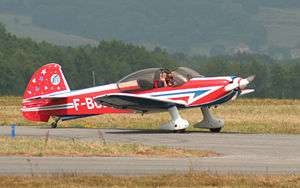Mudry CAP 10
The Mudry CAP 10 is a two-seat training aerobatic aircraft first built in 1970 and still in production in 2007. The plane was developed from the Piel Super Emeraude and was born as the CP100. The name changed to CAP 10, CAP for 'Constructions Aéronautiques Parisiennes'. The CAP 10 was manufactured by Mudry (name of its designer) in Bernay, France, bought by CAP Industries which then became Apex Aircraft. Following the bankruptcy of Apex in 2008, rights to produce spares were awarded to Dyn'Aviation. After the bankruptcy of DynAero in 2012,[1] manufacture of spares was taken over by CEAPR in Darois.
| CAP 10 | |
|---|---|
 | |
| CAP 10B #41 | |
| Role | Aerobatic aircraft |
| Manufacturer | Avions Mudry & Cie (now Apex Aircraft) |
| Designer | Nenad Hrisafović |
| First flight | 1968 |
| Produced | 1970-2007 |
| Number built | 300+ |
| Unit cost |
€160000 |
| Developed from | Piel Super Emeraude |
Design and development
The prototype C.P. 100 was first flown in August 1968 and was followed by the production variants, the CAP 10 and CAP 10B which had revised tail surfaces. The CAP 10 is a low-wing cantilever monoplane of wooden construction, with the CAP 10C having a carbon sandwich wing spar.
The engine is a 180 hp (130 kW) Lycoming AEIO-360 fuel injection engine, fully lubricated in inverted flight.
300+ aircraft were built, and in 2007 the CAP 10C is still in production as the CAP 10C NG.
The CAP 10 is one of the most successful aerobatic training aircraft in the world. About 200 aircraft are still flying in the late 2000s and nearly two generations of aerobatic champions made their classes with it.
In the late 70's the CAP 10 was developed to the single seater family of the CAP 20, 20L and 21. In the 1980s, a far derivative was the most successful family of the Cap 23x competition single seaters.
Variants
_(26646172513).jpg)
- C.A.A.R.P. C.P.100
- Prototype aircraft developed from the Piel Emeraude
- CAP 10
- Initial production aircraft
- CAP 10B
- Later production aircraft with ventral fin and enlarged rudder
- CAP 10C
- Improved structure with carbon-fibre wing spar.
- CAP 10R
- (R for Remorqueur - tower) Prototype of a glider tug version
- CAP 10B/K
- The exact same model as the CAP 10B modified through the implementation of a modification of the main wing spar approved under "MAJOR REPAIR DESIGN APPROVAL 10045153" by the EASA. This modification has been developed by the French Company Air-Menuiserie in 2013 and allows the CAP 10B/K to recover its flight envelop limitations (Maximum G-Force: +6.5G -4.5G).
Operators
Military

- Used to equip Equipe Voltige aerobatic display team.[3]

- The Mexican Air Force bought 20[2]

.svg.png)
- 3 operated by BAE Training Systems in Tamworth as part of the flight screening process on behalf of the Royal Australian Air Force, Royal Australian Navy and the Australian Army.
Civilian
More than 200 were built, mostly for aero-clubs all around the world. A huge number of European champions have started aerobatics on a Cap 10.
Specifications (CAP 10B)
Data from Jane's All The World's Aircraft 1988-89 [2]
General characteristics
- Crew: 2
- Length: 7.16 m (23 ft 6 in)
- Wingspan: 8.06 m (26 ft 5 in)
- Height: 2.55 m (8 ft 4 in)
- Wing area: 10.85 m2 (116.8 sq ft)
- Airfoil: NACA 23012
- Empty weight: 540 kg (1,190 lb)
- Max takeoff weight: 760 kg (1,676 lb)
- Fuel capacity: 72 l (19 US gal; 16 imp gal) + optional auxiliary tank of 75 l (20 US gal; 16 imp gal) capacity
- Powerplant: 1 × Lycoming AEIO-360-B2F 4-cylinder air-cooled, horizontally opposed, fuel injected piston engine, 134 kW (180 hp)
- Propellers: 2-bladed Hoffmann fixed pitch wooden propeller
Performance
- Maximum speed: 270 km/h (170 mph, 150 kn)
- Cruise speed: 250 km/h (160 mph, 130 kn) 75% power
- Stall speed: 100 km/h (62 mph, 54 kn) flaps up
- 85 km/h (46 kn; 53 mph) flaps down
- Never exceed speed: 340 km/h (210 mph, 180 kn)
- Range: 1,200 km (750 mi, 650 nmi)
- Service ceiling: 5,000 m (16,000 ft)
- g limits: +6 -4.5
- Rate of climb: 6 m/s (1,200 ft/min) max at sea level
Footnotes
| Wikimedia Commons has media related to Mudry CAP-10. |
- Roy 2012.
- John W.R. Taylor, ed. (1988). Jane's All the World's Aircraft 1988-89. London: Jane's Information Group. pp. 78–79. ISBN 0-7106-0867-5.CS1 maint: ref=harv (link)
- Air International November 1985, p. 251.
References
- "The Royal Moroccan Air Force...A Seasoned Air Arm". Air International. Vol. 29 no. 5. November 1985. pp. 226–232, 250–252. ISSN 0306-5634.CS1 maint: ref=harv (link)
- Roy, Gil (14 January 2012). "Course contre la montre pour Dyn'Aéro". www.aerobuzz.fr. Archived from the original on 1 February 2012. Retrieved 23 March 2015.CS1 maint: ref=harv (link)